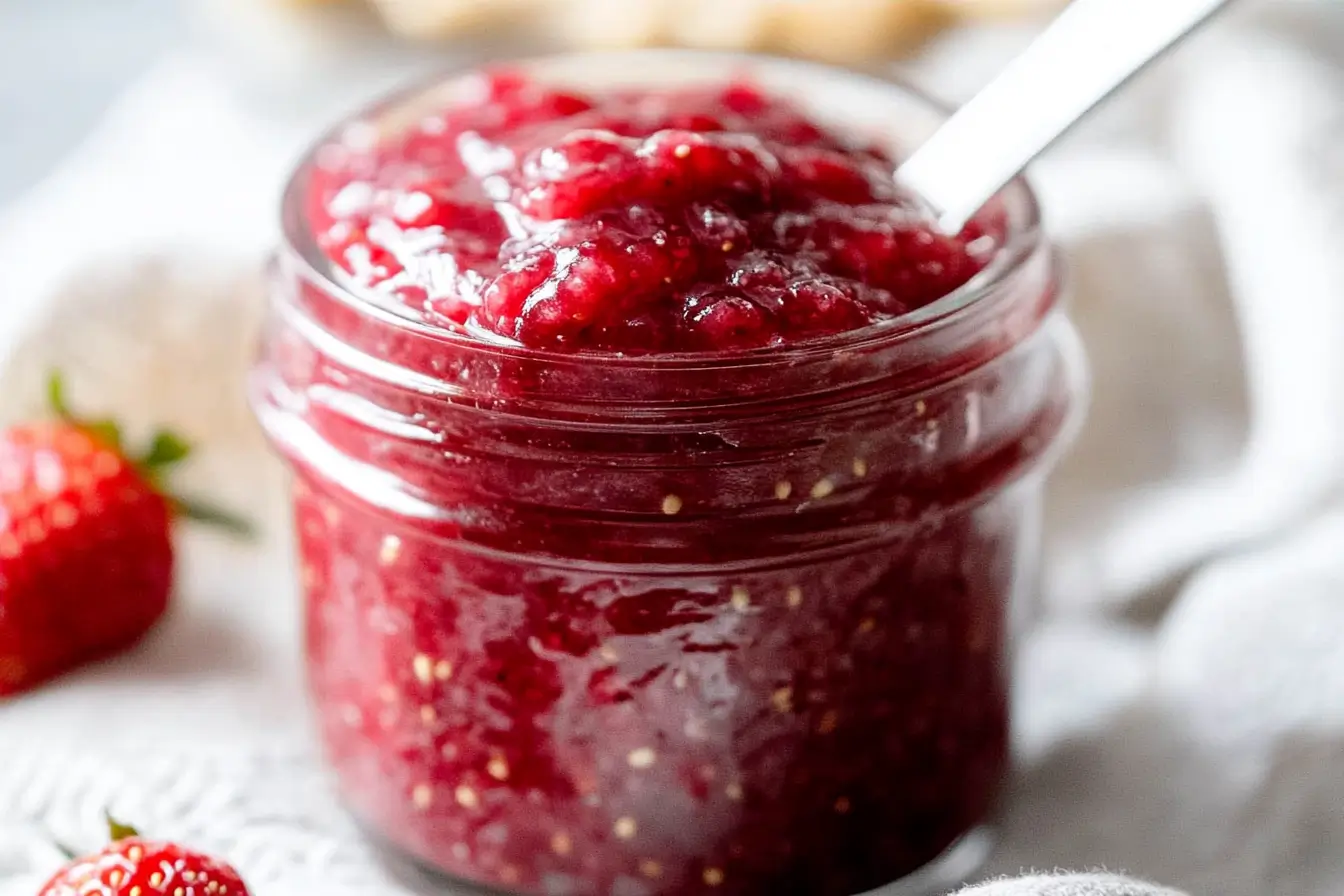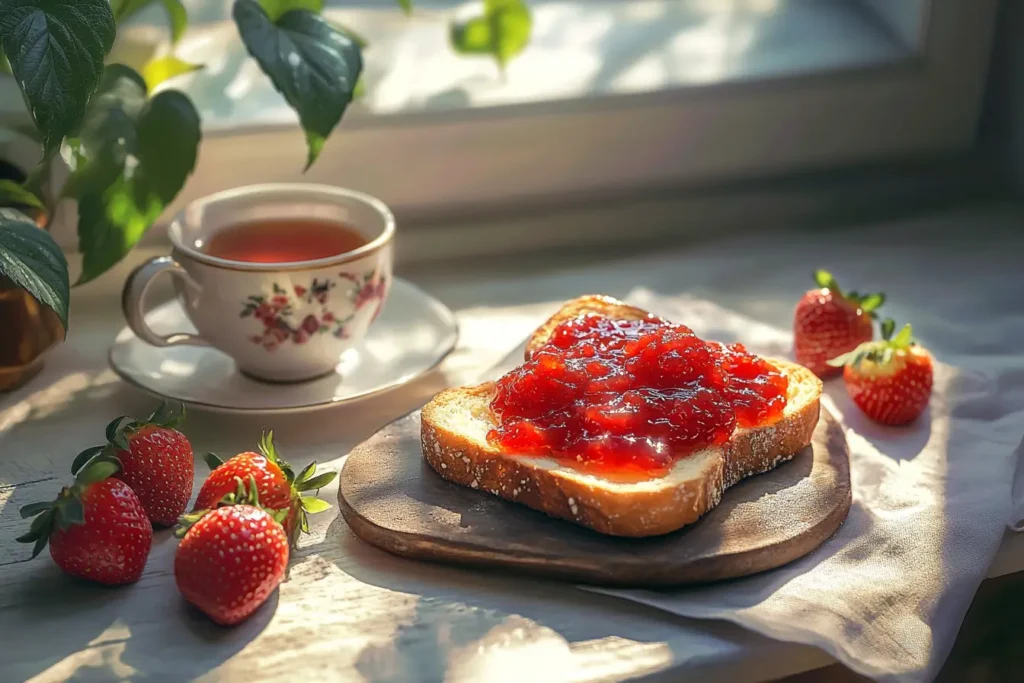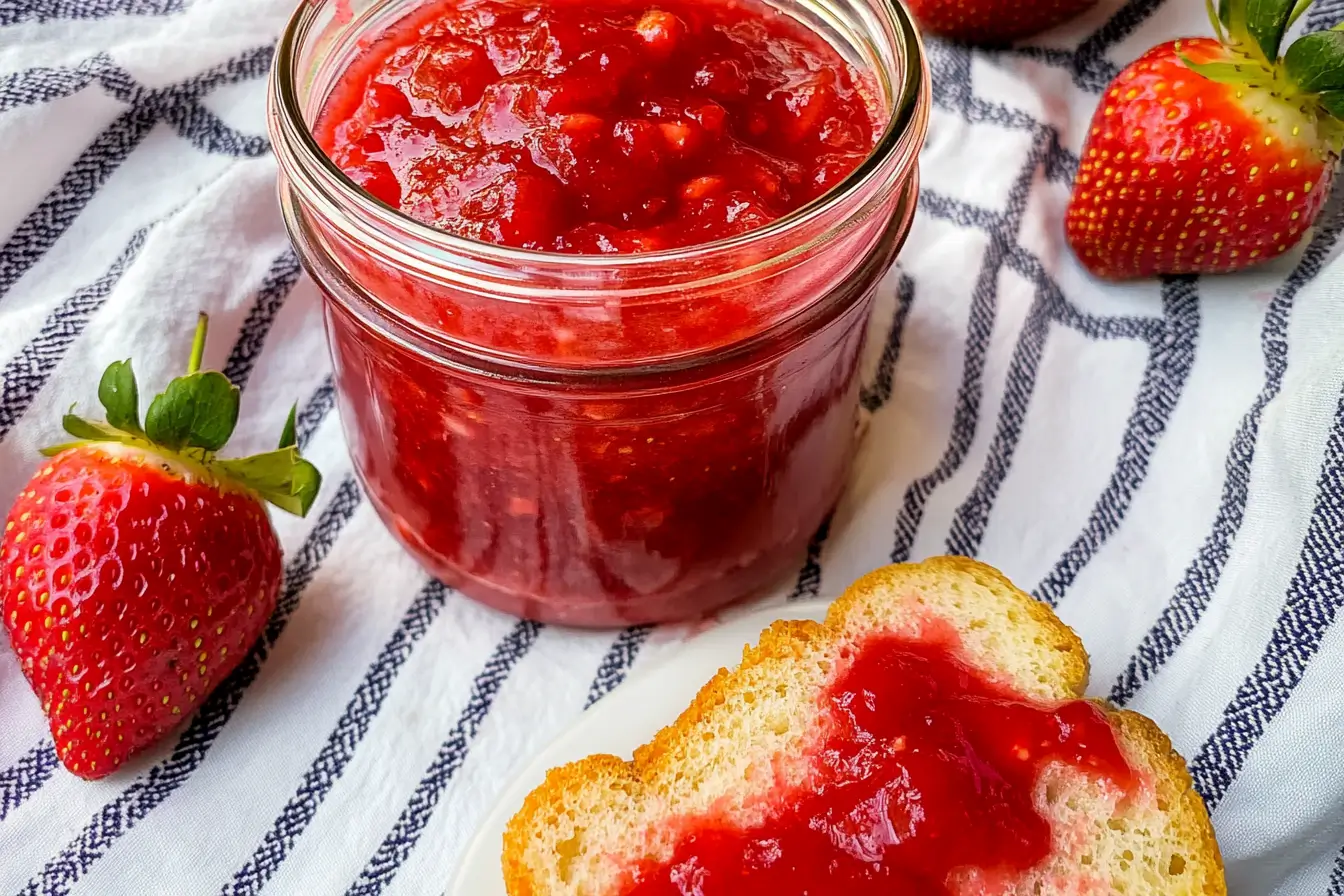Homemade strawberry preserves are a delicious way to enjoy the vibrant flavors of fresh strawberries all year round. But how long does homemade strawberry preserve last? The answer depends on proper preparation and storage techniques. Whether you’re canning, refrigerating, or freezing, understanding shelf life and spoilage signs is key to keeping your preserves fresh and safe. In this guide, we’ll explore everything you need to know about maximizing the longevity of your homemade strawberry preserves while savoring their natural sweetness.
Table of Contents
Understanding Homemade Strawberry Preserves
What Are Strawberry Preserves?
Strawberry preserves are a type of fruit spread made from strawberries, sugar, and sometimes pectin or lemon juice. Unlike jam, which is more spreadable, preserves are chunkier and contain whole or large pieces of fruit suspended in a syrupy mixture. Their rich texture and vibrant flavor make them a popular choice for spreading on toast, topping desserts, or even adding to savory dishes.
Strawberry preserves stand out because they strike a balance between sweetness and the natural tang of strawberries. However, the lack of artificial preservatives in homemade versions means they require careful storage to prevent spoilage.
Key Ingredients That Impact Shelf Life
The shelf life of homemade strawberry preserves depends on the ingredients used during preparation. Here’s how each key component plays a role:
- Sugar: Acting as a natural preservative, sugar helps inhibit the growth of bacteria and mold. Preserves with higher sugar content tend to last longer.
- Lemon Juice: The acidity of lemon juice not only enhances flavor but also creates an environment that discourages the growth of harmful microorganisms.
- Pectin: While optional, this thickening agent can also contribute to shelf life by stabilizing the mixture.
The balance of these ingredients directly affects how long your preserves stay fresh.
Differences Between Preserves, Jams, and Jellies
It’s easy to confuse preserves with other fruit spreads like jam or jelly. Here’s a quick breakdown:
- Preserves: Contain chunks of fruit, offering a hearty texture.
- Jam: Made from crushed fruit, resulting in a smoother consistency.
- Jelly: Made from fruit juice, creating a clear and firm spread.
Understanding these differences can help you better appreciate the unique characteristics of strawberry preserves and their storage needs.
Factors Affecting the Shelf Life of Homemade Strawberry Preserves

Storage Conditions: Room Temperature, Fridge, and Freezer
How long does homemade strawberry preserve last? Well, the answer depends heavily on where and how it’s stored. If the preserves are left unopened and stored in a cool, dark pantry, they can last for up to a year or longer when properly sealed. However, once opened, they should be refrigerated to slow down spoilage. Refrigeration keeps the preserves safe to eat for about three weeks to one month.
Freezing, on the other hand, offers the longest shelf life. If stored in an airtight container, frozen strawberry preserves can remain fresh for up to six months, retaining their vibrant color and flavor. Properly thawing them in the fridge before use is crucial to maintain their texture.
Impact of Sugar and Preservatives on Longevity
Sugar acts as a natural preservative in homemade strawberry preserves. It prevents bacteria and mold from growing, which is why recipes with a high sugar content typically last longer. Still, it’s important to note that lower-sugar or sugar-free versions might spoil faster unless additional measures like freezing are used.
Additionally, some recipes call for preservatives like citric acid or lemon juice. These ingredients create an acidic environment that limits bacterial growth and helps the preserves stay fresh longer.
Role of Canning and Vacuum Sealing in Preservation
Canning is a highly effective preservation technique that extends the shelf life of strawberry preserves. When jars are vacuum-sealed during the canning process, they become airtight, creating a barrier against contaminants. This method can keep preserves safe for up to a year without refrigeration, making it ideal for long-term storage.
For more detailed tips on canning, check out the guide on how to make strawberry preserves, which breaks down the process step-by-step.
How to Properly Store Strawberry Preserves for Maximum Freshness

Tips for Sterilizing and Sealing Jars Before Storage
Before storing your homemade strawberry preserves, sterilizing jars is a must. Sterilized jars prevent contamination and keep your preserves fresh longer. Simply boil the jars and lids in hot water for about 10 minutes before filling them. Once filled, ensure the lids are tightly secured to create an airtight seal.
Recommended Containers and Best Practices for Refrigeration
Once the jar is opened, transfer any leftover preserves into a smaller, airtight container to minimize exposure to air. Always store it in the coldest part of the fridge, not the door, to keep the temperature consistent. This simple practice can extend the shelf life by several days.
Freezing Strawberry Preserves: Pros, Cons, and Tips
Freezing is a great way to preserve a large batch of preserves and keep them fresh for longer. Store them in airtight, freezer-safe containers or resealable bags to avoid freezer burn. Be sure to leave some room in the container for expansion as the preserves freeze.
However, keep in mind that freezing can slightly alter the texture, making the fruit pieces softer when thawed. If you plan to use the preserves in recipes like smoothies or sauces, this won’t be an issue.
Signs That Homemade Strawberry Preserves Have Gone Bad
Common Spoilage Indicators: Mold, Smell, and Taste
Even with the best storage practices, strawberry preserves can spoil over time. Knowing how to spot signs of spoilage is crucial to ensure safety. The most obvious indicator is mold, which may appear as fuzzy, white, green, or blue patches on the surface. If you see mold, it’s best to discard the entire jar, as spores can spread throughout the preserves.
Another red flag is an off smell. Preserves should have a sweet and fruity aroma, so if they smell sour or fermented, it’s time to toss them. Lastly, pay attention to the taste. If the flavor has turned tangy, bitter, or just “off,” it’s a clear sign the preserves are no longer safe to eat.
What Is the White Stuff in Strawberry Preserves?
Sometimes, a white layer may appear on the surface of strawberry preserves. This could be harmless sugar crystallization, especially if the preserves were stored at fluctuating temperatures. However, if the white substance has a powdery or fuzzy appearance, it’s likely mold.
If you’re unsure whether the white layer is sugar or mold, it’s safer to discard the jar. Avoid tasting questionable preserves to prevent any health risks.
Safety Tips for Handling Spoiled Preserves
Always use a clean, dry spoon to scoop preserves from the jar, as introducing moisture or crumbs can speed up spoilage. Store opened jars in the fridge and tightly reseal them after each use. If you notice any signs of spoilage, don’t try to salvage the preserves—just throw them away.
If you’re interested in learning how to reduce waste, you might enjoy exploring creative ways to use leftover preserves. Check out our strawberry preserves recipe for inspiration on making smaller batches that suit your needs.
How Long Does Homemade Strawberry Preserve Last?

Typical Shelf Life: Unopened vs. Opened Jars
So, how long does homemade strawberry preserve last? Unopened jars stored in a cool, dark place can last up to a year, provided they were properly canned and sealed. However, once opened, their shelf life shortens significantly. Refrigerated preserves typically remain fresh for about three to four weeks. Beyond this period, watch for signs of spoilage like mold or an off smell.
Does Adding Lemon Juice or Pectin Extend Shelf Life?
Adding lemon juice or pectin can slightly extend the shelf life of strawberry preserves. Lemon juice increases acidity, which slows bacterial growth, while pectin helps create a stable, gel-like consistency that protects the preserves from air exposure. These ingredients not only enhance preservation but also improve flavor and texture.
If you’re curious about experimenting with other methods to boost shelf life, check out the recipe for canning homemade strawberry preserves, which includes helpful tips for sterilizing jars and creating airtight seals.
Comparison of Homemade vs. Store-Bought Preserves
Homemade strawberry preserves often have fewer preservatives than store-bought varieties, which means they’re fresher and more natural but may spoil faster. Store-bought preserves are designed for longer shelf life, thanks to additives and vacuum-sealed packaging. If convenience and longevity are your priorities, store-bought might be the better option. However, if you value flavor and knowing exactly what’s in your food, homemade is the way to go.
FAQs
What Is the Difference Between Strawberry Jam and Strawberry Preserves?
Strawberry jam and strawberry preserves are often confused, but they’re not quite the same. The key difference lies in texture and fruit content. Jam is made by mashing fruit, resulting in a smooth and spreadable consistency. In contrast, preserves are made with chunks of whole fruit suspended in syrup, giving them a thicker, chunkier texture.
Preserves are ideal for those who love biting into pieces of real fruit, while jam works well for smoother spreads on toast or pastries. Both are delicious, but the choice depends on your preference for texture and flavor.
How Long Does Homemade Strawberry Preserve Last?
One of the most common questions is, how long does homemade strawberry preserve last? The answer depends on storage and preparation methods. When unopened and stored in a cool, dark place, properly canned strawberry preserves can last up to a year. Once opened, they typically remain fresh for three to four weeks in the refrigerator.
If you’ve opted for freezing your preserves, they can stay good for up to six months, though you may notice slight changes in texture once thawed. Always watch for spoilage signs like mold or off smells to ensure safety.
What Is the White Stuff in Strawberry Preserves?
The white stuff that occasionally forms on the surface of strawberry preserves could be sugar crystallization, especially if the mixture contains a high sugar concentration. However, if it looks powdery or fuzzy, it’s likely mold.
To avoid this, store preserves in consistent temperatures and use clean utensils when scooping them out. If you’re unsure about the safety of your preserves, it’s better to err on the side of caution and discard the jar.
Why Add Lemon Juice When Making Strawberry Preserves?
Lemon juice plays a crucial role in making strawberry preserves. First, it balances the sweetness of the sugar and enhances the natural strawberry flavor. More importantly, it increases acidity, which helps prevent the growth of bacteria and other harmful microorganisms.
For those curious about using lemon juice in preserves, consider it an essential ingredient not just for flavor, but for food safety.
Final Thoughts and Practical Tips
Homemade strawberry preserves are a wonderful way to capture the sweet, tangy taste of fresh strawberries. By understanding the factors that affect their shelf life and following proper storage techniques, you can enjoy your preserves for weeks or even months.
So, how long does homemade strawberry preserve last? With proper canning, refrigeration, or freezing, they can remain safe and delicious for an extended time. But always remember to watch for spoilage signs and handle your preserves with care to ensure safety.
If you’re ready to dive into the world of homemade preserves, why not try your hand at making your own? For inspiration, check out this easy strawberry preserves recipe, and start your journey toward enjoying fresh, homemade flavors all year long!
Conclusion
Homemade strawberry preserves are more than just a tasty treat; they’re a way to enjoy the essence of ripe, fresh strawberries long after their season ends. Whether you’re spreading them on toast, layering them into desserts, or pairing them with savory dishes, preserves offer unmatched versatility. But, as with any homemade food, understanding their shelf life and storage needs is crucial for safety and flavor.
Why Knowing Shelf Life Matters
Knowing how long homemade strawberry preserve lasts ensures you get the best out of your effort. Preserves that are properly canned and sealed can remain safe for up to a year when stored in a cool, dark pantry. This long shelf life makes them a perfect option for stocking up on seasonal fruit or preparing thoughtful, homemade gifts for loved ones.
However, once a jar is opened, the rules change. Refrigeration is essential to keep the preserves fresh, typically lasting three to four weeks before signs of spoilage appear. Freezing extends this timeline even further, making it an excellent option if you’ve made a large batch and want to avoid waste.
How to Extend the Life of Your Preserves
To make the most of your homemade preserves, it’s essential to follow a few key practices:
- Proper Sterilization: Start with clean jars. Sterilizing jars before use removes bacteria and other microorganisms that can spoil your preserves.
- Seal It Tight: Airtight seals are your best defense against spoilage. Be sure to follow canning guidelines carefully to create a vacuum seal that keeps air out.
- Store Smart: Unopened jars should be stored in a cool, dark place. Once opened, always refrigerate the jar and use clean utensils to prevent contamination.
Creative Ways to Enjoy Strawberry Preserves
While you may think of strawberry preserves as a simple breakfast staple, they’re far more versatile than that! Try these ideas:
- Desserts: Use them as a filling for cakes, swirled into cheesecake, or as a topping for ice cream.
- Savory Pairings: Pair preserves with soft cheeses like brie or goat cheese for a sweet-and-savory appetizer.
- Beverages: Stir a spoonful into sparkling water or cocktails for a fruity twist.
Experimenting with these options not only helps you enjoy your preserves but also ensures none of it goes to waste.
Enjoying the Art of Homemade Preserves
Making strawberry preserves isn’t just about extending the shelf life of your fruit—it’s about embracing a tradition that turns simple ingredients into something extraordinary. The process itself can be deeply rewarding, from the soothing act of simmering fresh strawberries to the satisfying pop of sealed jars cooling on the counter.
Plus, when you make your own preserves, you have full control over the ingredients. Whether you prefer a classic sweet version, a sugar-free option, or a unique flavor combination, the possibilities are endless. By incorporating ingredients like lemon juice or experimenting with spices, you can create a product tailored to your tastes.
Dernière mise à jour : 15 February 2025

